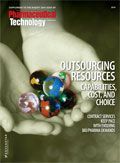Solid-Dosage Forms Demand Traditional and Emerging Technologies
Contract development and manufacturing organizations identify trends, challenges, and emerging technology and service needs for solid and semi-solid dosage forms.
Nicholas Eveleigh/Getty Images

Poorly soluble APIs, high potency APIs and compounds, and alternate dosage forms such as capsules, test the formulation, development, and manufacturing capabilities of drug sponsors and contract service organizations alike. Pharmaceutical Technology spoke with representatives of contract development and manufacturing organizations to identify trends, challenges, and emerging technology and service needs for solid and semi-solid dosage forms.
Technical advances improve formulationPharmTech: What scientific or technical advances have positively or negatively impacted drug development processes in solid/semi-solid dosage drug development and manufacturing?
Park (Catalent Pharma Solutions): Innovation in oral solid dosage modified-release technologies and applications has experienced a surge in recent years. This can be largely attributed to the need for further differentiation of innovator drugs to optimize therapeutic product profiles to effectively compete in a more competitive and global marketplace. Positive advances include the adoption of newer delivery technologies such as oral absorption of biologics and hot melt extrusion (HME) among others.
Raheja (Dr. Reddy’s CPS): Technical advances including the decoding of the human genome, medical imaging, and new technologies that enable drug researchers to rapidly synthesize and screen numerous compounds have led to much greater availability of information to researchers. This has, in turn, impacted positively on drug development by expediting the process.
Ross (Metrics Contract Services): Spray-drying technologies have had a tremendously positive influence on formulation development. In addition to allowing scientists to render powder from a solution, spray drying can be useful for modifying particle sizes, agglomerating nanoparticles, and microencapsulation, thus expanding the array of drug-delivery options available to scientists when working with a specific API.
Negron (Patheon): Newer techniques for handling insoluble or poorly soluble active ingredients, NIR [near infrared] in-process analyses, PAT [process analytical technology] devices, and equipment with improved containment and CIP [clean in place] have all enhanced manufacturing processes.
Koontz (Xcelience): The advances in IT and communication continue to enhance our ability to improve the development process. We also see advances in manufacturing equipment that offers an increasingly wide range of capabilities. For example, many capsule-filling equipment manufacturers are able to provide many different filling techniques along with consistent filling at very low weights/volumes.
Emerging practices in demandPharmTech: What emerging technologies or practices do drug sponsors expect your organization to provide?
Negron (Patheon): Drug sponsors expect us to provide all of the traditional technologies, along with newer technologies like HME, spray-drying, liquid-fill hard gelatin capsules, active coating, and continuous processing. In addition, there is increased pressure on more robust processes, more agile supply chains, and lower costs.
Koontz (Xcelience): In the CDMO sector, current technologies continue to hold true. Clients expect to be able to utilize the latest tools with regard to solid dosage forms, including state-of-the-art equipment. They also want flexible and creative solutions to ensure their projects are executed in a timely manner. Environmental controls (i.e., low relative humidity, cold storage, etc.) are also becoming more critical.
Ross (Metrics Contract Services): Drug sponsors increasingly are looking to solid oral-dose formulation development experts for help maximizing the effective availability of API by using sophisticated modified-release technologies, as well as bioavailability improvement technologies suited for poorly soluble API. Through these technologies, formulation development scientists can develop products that deliver patient benefits such as reduced dosing frequency, an improved side-effect profile, and more consistent therapeutic effects. Drug sponsors also are looking to companies like Metrics Contract Services for early-stage strategies that allow them to streamline later-stage needs, including commercial production.
Raheja (Dr. Reddy’s CPS): Drug sponsors expect CPS to provide enabling technologies to make their drug substance into a commercially successful drug product. Expected practices include application of advanced analyticaltechniques and material sciences to the manufacturing processes, as well as application of PAT to reduce variability and improve reproducibility.
Park (Catalent Pharma Solutions)): Our customers expect deep expertise and innovative solutions to help them get more molecules to market faster while creating better treatments for patients, in an increasingly competitive environment, that is subject to strong payer pressures. For example, emerging trends include more combination therapies, molecules that require absorption beyond the gastric tracts, non-invasive methods of delivering biologics and delivery methods resistant to abuse.
New service demandsPharmTech: Are you seeing shifts in demand for particular types of services?
Raheja (Dr. Reddy’s CPS): More and more innovators are looking to outsource supplies, but initial drug development is something they want to keep in-house. Innovator companies are looking for outsourcing operations involving later phases of development including manufacturing GMP supplies and shipping to the clinical-trial sites.
Park (Catalent Pharma Solutions): We have seen an increase in demand for technologies that are effective for the delivery of poorly bioavailable products. Our recent investments in HME, to broaden our OptiMelt technology platform, are in response to increased customer demand, particularly in the post proof-of-concept stages of process development and scale-up. Additionally, our customers are becoming increasingly global and need global supply capabilities, as well as global R&D capabilities, and an understanding of regional needs.
Ross (Metrics Contract Services): As a whole, the pharmaceutical industry is seeing growth in the proportion of potent and cytotoxic API in the pipeline. At Metrics Contract Services, we met this challenge by custom-engineering a dedicated facility that provides total containment using hard-wall isolation technologies. Our multi-use, hard-wall isolators accommodate different pieces of processing equipment, allowing clients to select only those capabilities needed for particular projects.
Negron (Patheon): There seems to be a shift toward more complex formulations and processes, controlled-release combination products, abuse-deterrent formulations, active coatings, and techniques for handling insoluble compounds.
Koontz (Xcelience): The big shifts we are seeing involve timing, creativity, and flexibility. Clients expect creative and flexible ways to achieve their needs and they expect them faster.
Solubility and formulation solutionsPharmTech: What pressing technical challenges have you seen in solid/semi-solid dosage development? What actions has your company taken to resolve the challenges? What actions does your company suggest?
Ross (Metrics Contract Services): An increasing proportion of API is poorly soluble. Metrics Contract Services offers its drug-delivery technology called SUBA that involves co-processing poorly soluble API with a cellulosic enteric polymer. Co-processing with the enteric cellulosic polymer reduces particle size and hinders further re-crystallization of the API, allowing for a higher level of bioavailability in the small intestine. We developed an in-vitro analytical technique to test whether we’ve successfully achieved a sub-micron particle size distribution of the poorly soluble API. A drug sponsor wants to know right away whether SUBA technology even works for their API, so in-vitro testing allows us to determine that quickly before conducting expensive bioequivalence trials.
Raheja (Dr. Reddy’s CPS): In the past decade, we have seen a trend and demand for services to address challenges involving poorly soluble NCEs, customizing drug release for specific indications and patient populations, and handling high potent products. In manufacturing, major challenges include scaling up complex unit operations to produce reproducible products. At Dr. Reddy’s, application of PAT and quality by design is a mandatory part of product development.
Negron (Patheon): More complex formulations and processes require more stringent development to better understand the material characteristics, critical process parameters, and quality attributes of the materials and product. Design of experiments is one tool to help assure a quality outcome.
Park (Catalent Pharma Solutions): According to surveys that Catalent conducted at its recent Applied Drug Delivery Institute events, drug release profile, stability and solubility of the API, and abuse deterrence were the most significant challenges. Customers are increasingly looking for partners to provide solutions to improve the bioavailability of their development products or to optimize the treatment to patients.
What’s ahead for solid/semi-solid dosages?PharmTech: What advances do you see in science or technology in this market segment in the next five years?
Koontz (Xcelience): In my opinion, we will continue to see equipment designed with increased ability to consistently fill capsules at very low weights. We will also see equipment with modular capabilities that increase the overall breadth of processing options within one footprint.
Raheja (Dr. Reddy’s CPS): Processes for drug development are becoming increasingly automated. A lot of incremental improvements have developed for process knowledge and technical capabilities. Over the next five years, application of design of experiment will ensure that processes will be much more robust and lead to reproducible batches of complex operations.
Negron (Patheon): We will see a shift away from high volume, commodity products, to smaller more complex products targeted at niche indications. Equipment will move to smaller volume, higher containment, and more flexible changeovers.
Discussion ParticipantsMin Park, Group Product Manager, Advanced Delivery Technologies, Catalent Pharma Solutions
Praveen Raheja, Associate Director, Formulations, Dr. Reddy’s CPS
John S. Ross, Executive Vice-President, Metrics Contract Services
Franco Negron, Vice-President, N. America, Operations and Integration, Patheon Inc.
Theodore S. Koontz, Vice-President, Operations, Xcelience

Drug Solutions Podcast: A Closer Look at mRNA in Oncology and Vaccines
April 30th 2024In this episode fo the Drug Solutions Podcast, etherna’s vice-president of Technology and Innovation, Stefaan De Koker, discusses the merits and challenges of using mRNA as the foundation for therapeutics in oncology as well as for vaccines.